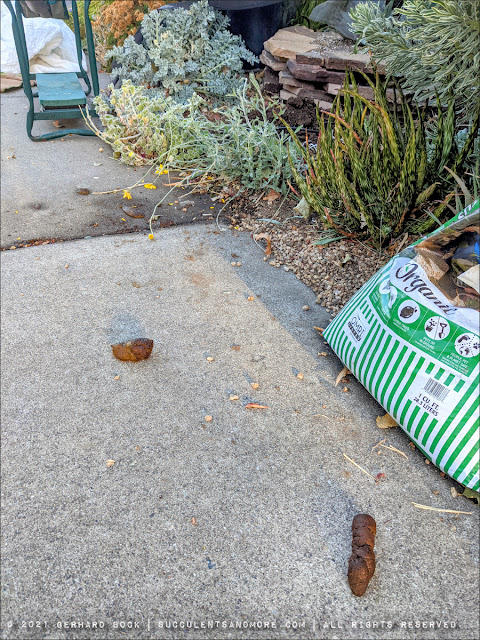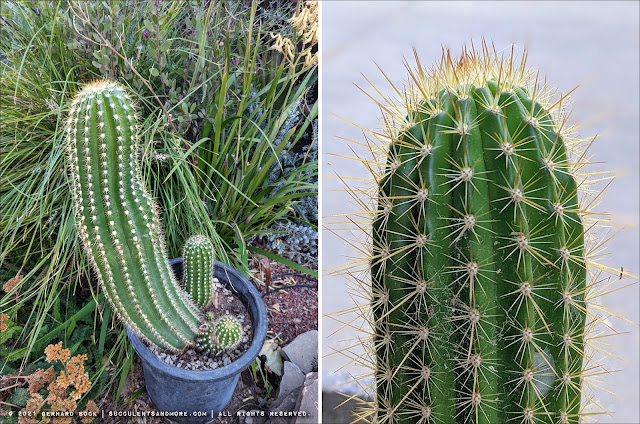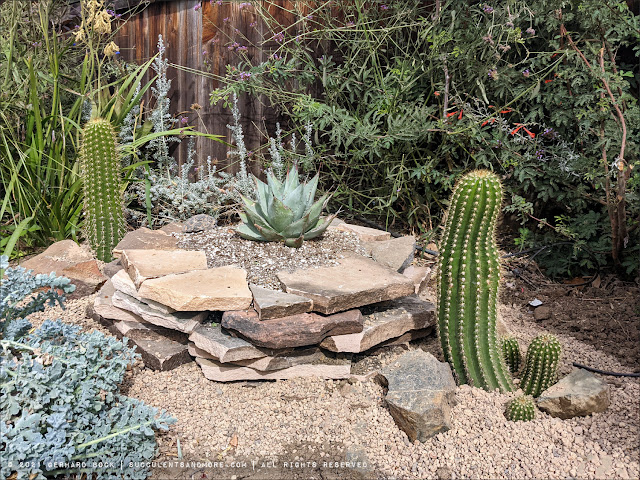Another week and weekend without rain. Isolated cells dropped some H₂O near us, but our part of Davis remained dry. However, downtown Sacramento's record of 212 consecutive days without measurable precipitation was broken, and that counts for something.
A sunny and mild weekend meant I was able to get work done in relative comfort. Project #1 involved relocating the plant producing the mass of strappy green leaves you see in the photo below:
 |
Drimia maritima (green leaves) and Euphorbia characias 'Tasmanian Tiger'
|
The wavy leaves belong to
Drimia maritima, commonly known as giant sea squill, a bulb native to the Mediterranean basin. Its leaves emerge in the fall and die back in late spring. In mid-summer, it produces tall inflorescences with masses of small white flowers (
see photo here taken at the UC Davis Arboretum).
I don't know if
Drimia maritima is the largest bulb in the plant world, but it's got to be close. According to
Wikipedia,
Drimia maritima bulbs can be “up to 20 cm (7.9 in) wide and weigh 1 kg (2.2 lbs).” That's an
understatement, as you'll see in a second.
My
Drimia maritima was in the long sidewalk bed outside the front yard fence, at the base of a large clump of
Euphorbia characias 'Tasmanian Tiger'. As you can see in the photo below (taken on October 14, 2021), new leaves are emerging from the bulb. The contrast between the drimia and euphorbia is beautiful, but the leaves, ephemeral as they are, invariably smother other plants nearby, like the
Aloe 'Verity Nice' shown below. This year, the situation would have been even worse because I planted an
Echinopsis 'Flying Saucer' nearby (project #2 below).
 |
| Drimia maritima leaves emerging; Aloe 'Verity Nice' (Aloe zubb × peckii) in the foreground |
I'd been thinking of removing my Drimia maritima for several years, but now, with the Echinopsis going in the ground nearby, I had a concrete reason to do so.
Contrary to what I'd expected, digging up the bulb took a fair amount of time and shovel work. After the fact, it's easy to see why:
 |
| Dug up Drimia maritima bulb with my hand for scale |
My
Drimia maritima bulb was 22 inches from the top of the emerging leaves to the bottom of the roots, 11 inches side to side, and 38 inches in circumference. Remember
Wikipedia says “up to 20 cm (7.9 in) wide:” My bulb is already 3 inches wider than that! I forgot to weigh it, but it's
much heavier than Wikipedia's 2.2 lbs—I'd say at least 5 lbs.
 |
| As purchased at the Home Depot in September 2013 |
I'd already picked out a new home for Drimia maritima, on the edge of the clump of Bambusa oldhamii around the corner from where it had spent the last 8 years. Initially, I dug a hole that was way too small, causing more than half of the bulb to stick out above ground, but eventually I got it right:
When I came out on Saturday morning to start project #2, this is what I found waiting for me on the sidewalk:
 |
| Dog poop aside, that's Aloe 'Verity Nice' behind the bag of soil. The Drimia maritima had been in the ground right behind it. |
Fortunately, we don't find dog doodoo on the sidewalk all that often, but I was still annoyed. Nobody can pretend they didn't notice their pooch pooping, especially when it's spread out like this! I didn't want this to ruin my day, so I quickly cleaned it up and went on with my work.
Project #2 involved planting
Echinopsis hybrids on either side of the
flagstone throne occupied by
Agave sebastiana 'Silver Lining':
Echinopsis 'Flying Saucer' (
flower photo here) on the left, and
Echinopsis 'First Light' (
flower photo here) on the right. The spines on these cacti may not seem all that menacing, but they're still poky enough to penetrate even “puncture-proof” gloves.
 |
| Echinopsis 'Flying Saucer' (left) and 'First Light' (right) |
When handling larger cacti like these, I've used a variety of things over the years, from old towels to pieces of rugs or carpeting. Recently, I found something that's much lighter and works even better: an old leak-proof mattress cover. It has a plastic liner on the bottom and soft quilted fabric on top. Wrapped around these echinopsis, it offered full protection—both for the spines (they didn't get crushed or broken) and my hands (they didn't get poked).
 |
| Echinopsis 'First Light' about to be wrapped with an old leak-proof mattress cover |
Getting these two Echinopsis in the ground involved a bit of man-handling because they were fairly heavy (especially 'Flying Saucer' on the right), but I was ready for it.
 |
| Echinopsis 'First Light', Agave sebastiana 'Silver Lining', Echinopsis 'Flying Saucer' |
Here they are in their new home: Echinopsis 'First Light' on the left and Echinopsis 'Flying Saucer' and its four pups on the right, with Agave sebastiana 'Silver Lining' in between:
 |
| Echinopsis 'First Light', Agave sebastiana 'Silver Lining', Echinopsis 'Flying Saucer' |
The gray-blue leaves you see along the bottom in these photos belong to an orange-flowering horned poppy (Glaucium flavum var. aurantiacum) that I got from Annie's Annuals. It's produced beautiful foliage, but no flowers yet.
I quickly mulched the cactus with 5⁄16" lava rock but left the finishing touches for later. I still want to plant some flowering perennials in the very front, or possibly a few low-growing echinopsis hybrids with flower colors that complement the pink and magenta hues of 'Flying Saucer' and 'First Light'. I'm not under any time pressure and can wait until I have it figured out in my head. As the saying goes, “think twice, plant once.”
Project #3 was the most dramatic project I did this weekend, so I'll save it for a separate post.
© Gerhard Bock, 2021. All rights reserved. To receive all new posts by email, please subscribe here.











The Drimia and Euphorbia do look good together but I understand your decision. I have 5 of the bulbs (4 of which were planted last year) on my back slope near the property line, where they don't interfere with anything. Unfortunately, not a single plant bloomed this year despite developing foliage earlier last winter. I blame the lack of water as there's no irrigation there. However, I feel no compulsion to move them elsewhere where they might get some water in the absence of rain - they are ridiculously heavy.
ReplyDeleteDrimia maritima is TOUGH as far as irrigation is concerned. Mine took five years before it finally flowered!
DeleteThe bulbs are surprisingly heavy!
The Drimia is truly impressive. Where is it's new home? The newly planted Echninopsis look great. Can't wait to see them bloom as their flowers are stunning. Do the flowers last longer than a few hours?
ReplyDeleteThe Drimia moved to another area of same long bed, at the base of a clumping bamboo.
DeleteThe flowers of both Echinopsis 'Flying Saucer' and 'First Light' are short-lived, a day max., but supposedly these hybrids flower repeatedly through spring and summer. Fingers crossed.
I also transplanted my Drimia maritima here about a week ago. At the time it was dormant. About 3 days after the move to a sunny spot it produced the green of the leaves. I got mine from Jan Emming a few years ago. It only bloomed one time, but I love the green leaves. Anything green is great here in Phoenix. I am hoping the increase in sun will help it decide to bloom. I have a gardening friend in Portugal and he said they bake in the sun there and bloom rather easily.
ReplyDeleteI agree, the leaves are beautiful. That's why I got my Drimia maritima in the first places. The flowers are a nice bonus, but nothing to write home about.
DeleteTrue, but the flower stalk is different and fun. The leaves are definitely the biggest payoff though!! I love all your adventures in your garden and other people's gardens!
DeleteNancy, me too! There are so many cool plants to discover and so projects to be inspired by.
DeleteI'm really enjoying reading about your planting projects -- not sure my comments are getting through with the new laptop! Drimia is a tricky bulb to place. I've always coveted the spires but could never find the right spot.
ReplyDeleteDenise, this comment definitely made it. I also had problems with Blogger recently, but it seems to be fixed now.
DeleteDrimia maritima isn't easy to place, you're right. The foliage takes up a good chunk of space, then the plant goes dormant and you're left with a big hole before the flowers come.